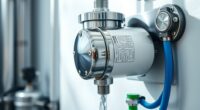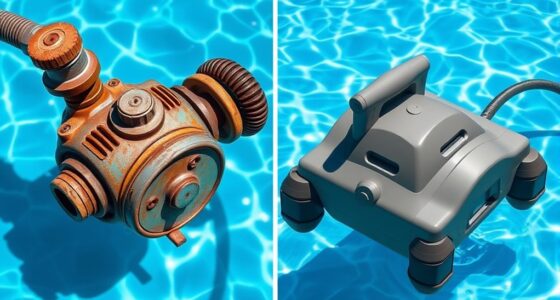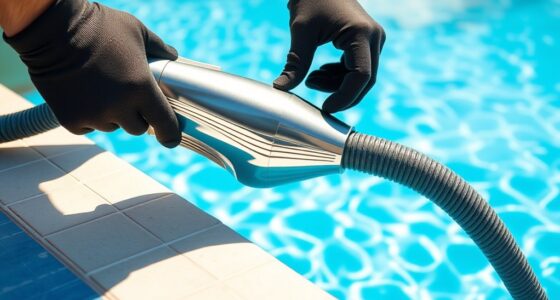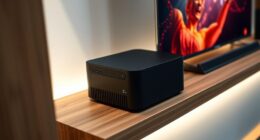Pressure pool cleaners use high-pressure water jets powered by your pool’s filtration system or booster pump, making them affordable but often requiring manual maintenance. Robotic cleaners operate independently with onboard motors, steering automatically to scrub and vacuum debris efficiently while consuming less energy. While robotic models tend to cost more upfront, they offer better cleaning performance and ease of use. To discover which option suits your pool best and learn more, keep exploring the details below.
Key Takeaways
- Pressure pool cleaners rely on water pressure from the pool system, while robotic cleaners operate independently with onboard motors.
- Robotic cleaners offer advanced navigation and thorough cleaning, especially in complex or irregular pool shapes.
- Pressure cleaners are generally less expensive initially but may require more maintenance and effort to operate.
- Robotic cleaners are energy-efficient, consume less power, and often include programmable features for customized cleaning schedules.
- Robotic models provide better debris removal, surface coverage, and can adapt to different water conditions compared to pressure cleaners.
How Pressure Pool Cleaners Operate

Pressure pool cleaners operate by using high-pressure water supplied from a dedicated booster pump or the pool’s existing filtration system. This pressurized water powers the cleaner’s movement and debris removal. As the cleaner moves around, it directs water toward the pool’s water filtration system, helping trap dirt, leaves, and other debris. During operation, the cleaner’s water jets push it along surfaces, while the debris it collects is filtered out of the pool water. It’s important to note that these cleaners don’t directly affect the pool chemical balance but rely on the filtration system to keep water clear and clean. Properly functioning water jet propulsion is essential for the cleaner’s effective movement and debris removal. Additionally, regular maintenance of the filtration system enhances overall cleaning efficiency. Well-maintained water circulation ensures optimal operation of pressure pool cleaners. Proper pressure regulation is also vital to prevent damage and ensure consistent cleaning performance. By working in tandem with your pool’s existing water filtration, pressure pool cleaners efficiently maintain a tidy swimming environment without manual effort.
How Robotic Pool Cleaners Function

Robotic pool cleaners operate independently by using onboard motors and advanced navigation systems to move around the pool. They detect dirt and debris, modifying their path to cover the entire surface efficiently. These cleaners analyze water temperature to optimize cleaning cycles and adapt to different pool conditions. They often include sensors to avoid obstacles and guarantee thorough cleaning without manual intervention. As they work, they dispense or work alongside pool chemicals, maintaining water quality. Their intelligent systems allow them to focus on areas with more debris or algae buildup, saving you time. Additionally, the integration of automated navigation systems enhances their efficiency and coverage. Many models also feature self-docking capabilities, allowing them to recharge automatically when their task is complete. Advances in sensor technology enable even more precise targeting of dirty areas, further improving cleaning performance. Incorporating spatial awareness allows these cleaners to optimize their routes and avoid redundant coverage, increasing overall efficiency. Furthermore, vibration sensors help in detecting heavily soiled spots, ensuring comprehensive cleaning.
Cost Comparison Between Pressure and Robotic Cleaners

While robotic pool cleaners offer advanced navigation and autonomous operation, their initial purchase price is generally higher than pressure cleaners. Robotic models typically have a fixed cost, but some vendors offer flexible pricing models, including leasing options or installment plans, making them more accessible. Pressure cleaners usually cost less upfront, but may require additional expenses for hoses and accessories. Warranty coverage varies; robotic cleaners often come with comprehensive warranties covering parts and repairs for at least a year, which can reduce long-term costs. When comparing costs, consider the initial investment, potential maintenance expenses, and warranty coverage to determine which cleaner provides better value for your budget. Additionally, maintenance requirements for robotic cleaners tend to be more complex but are often offset by their durability and advanced features. It’s also worth noting that robotic models are often designed with energy efficiency in mind, potentially lowering ongoing operating costs. Moreover, understanding the cost-effectiveness of each type can help in making a more informed decision based on your specific needs. Furthermore, selecting a cleaner with energy-efficient components can contribute to lower electricity bills over time.
Energy Efficiency and Power Consumption
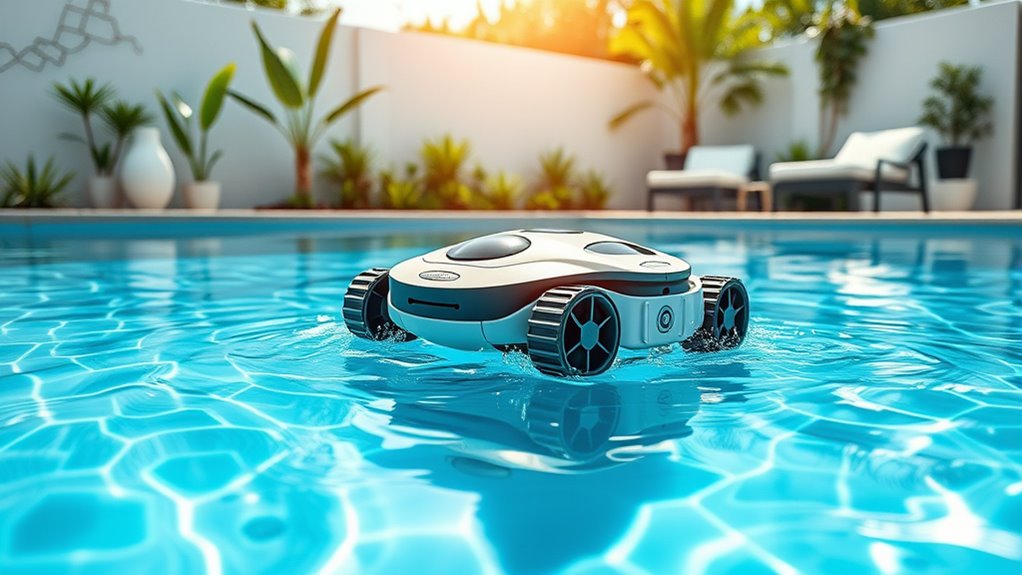
You’ll want to compare how much energy each cleaner uses during operation, as power consumption can vary considerably. Look for models with energy-saving features that reduce electricity use without sacrificing cleaning power. Understanding operational efficiency helps you choose a cleaner that cleans effectively while keeping ongoing energy costs low.
Power Usage Differences
When comparing power usage, robotic pool cleaners generally consume less energy than pressure pool cleaners, making them more energy-efficient over time. They use electricity efficiently for water filtration and debris collection, reducing overall power consumption. Robotic cleaners typically operate on low-voltage systems, which helps lower energy costs and minimizes environmental impact. In contrast, pressure cleaners often rely on high-pressure water from your pool’s pump, consuming more power. Additionally, robotic cleaners often feature smart navigation, optimizing their cleaning paths and reducing unnecessary operation. This smart technology improves their efficiency and helps conserve energy, which aligns with sustainable practices and reduces your household’s carbon footprint. Furthermore, many robotic models incorporate energy-saving modes, further enhancing their efficiency during operation.
Energy Saving Features
Robotic pool cleaners are designed with energy-saving features that make them more efficient than traditional pressure models. Many models incorporate solar integration, allowing them to harness sunlight and reduce electricity consumption. This eco-friendly feature lowers operational costs and supports sustainable practices. Additionally, smart technology enables these cleaners to optimize their cleaning cycles, adjusting power usage based on the pool’s size and debris level. Some units even schedule cleaning sessions during off-peak hours to further conserve energy. These features guarantee you get effective cleaning without wasting electricity or energy. By choosing a robotic cleaner with solar integration and smart technology, you maximize efficiency while minimizing your environmental footprint. This combination makes robotic pool cleaners a smarter, greener choice for pool maintenance. Energy optimization ensures these devices utilize power most effectively, enhancing their overall efficiency and sustainability. Incorporating power management systems further enhances their ability to conserve energy during operation.
Operational Efficiency
Robotic pool cleaners stand out for their impressive operational efficiency, particularly regarding energy use and power consumption. They typically run on low voltage, consuming less electricity than pressure cleaners, which often require additional pumps. This efficiency reduces your energy bills and minimizes environmental impact. Plus, advanced models allow you to customize cleaning schedules and control functions easily through user control features, optimizing operation times and power use. Their design also simplifies filter maintenance, making it quick to clean or replace filters without disrupting performance. Additionally, smart technology further enhances their operational efficiency by enabling precise and adaptive cleaning patterns. Incorporating regional legal resources can also help homeowners understand any regulations related to electrical safety and environmental standards, ensuring compliant and eco-friendly operation.
Maintenance and Ease of Use
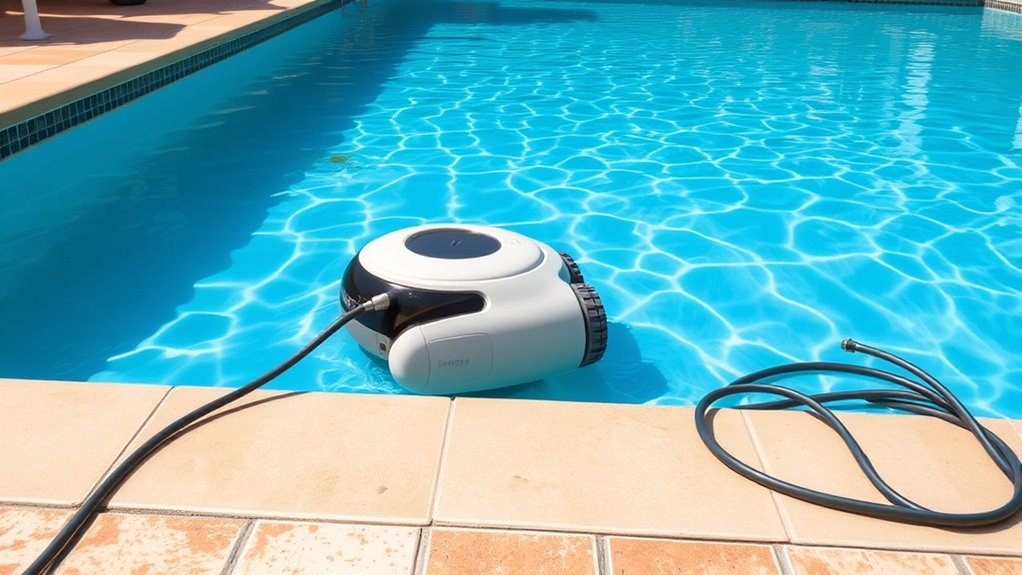
When it comes to maintenance and ease of use, you’ll want a cleaner that minimizes effort and fits your routine. Both pressure and robotic models vary in how easy they are to set up and store, impacting your overall experience. Let’s explore how their cleaning efficiency and setup processes compare to help you choose the best option. Additionally, understanding the privacy policies associated with these devices can help you make informed decisions about your data privacy during use. Choosing a model with easy-to-access parts can further reduce maintenance time and simplify repairs, ensuring your pool stays clean with minimal hassle. Being aware of cookie categories and your consent options can also enhance your online privacy while managing your device settings.
Cleaning Efficiency and Effort
While pressure pool cleaners are generally straightforward to operate, they often require more hands-on maintenance to guarantee ideal performance. You’ll need to regularly check the hoses and ensure proper water circulation to keep the cleaner working efficiently. They tend to be less effective at removing fine debris, which means you might need to vacuum or clean filters more often. Proper pool chemical balance helps improve cleaning results, but manual intervention is sometimes necessary. Additionally, cleaning the filter and inspecting the hose connections can prevent clogs and maintain excellent cleaning.
- Regularly check and clean hoses for debris buildup
- Keep pool water balanced to enhance cleaning efficiency
- Monitor water circulation and adjust skimmer settings as needed
Setup and Storage Ease
Setting up a pressure pool cleaner is generally straightforward, but it requires some effort to connect hoses and guarantee proper water flow. Once assembled, storage convenience becomes an important factor—these cleaners often need more space due to hoses, which can be cumbersome. While setup simplicity is decent, you’ll need to coil hoses neatly to prevent tangles and damage. Robotic cleaners, on the other hand, typically feature compact designs that are easier to store and require less setup time. They come pre-programmed and connect wirelessly, reducing hassle. Overall, pressure cleaners may take more effort to set up and store, but with some organization, they remain manageable. Robotic models excel in ease of storage and quick setup, making them more user-friendly for routine maintenance.
Cleaning Performance and Effectiveness
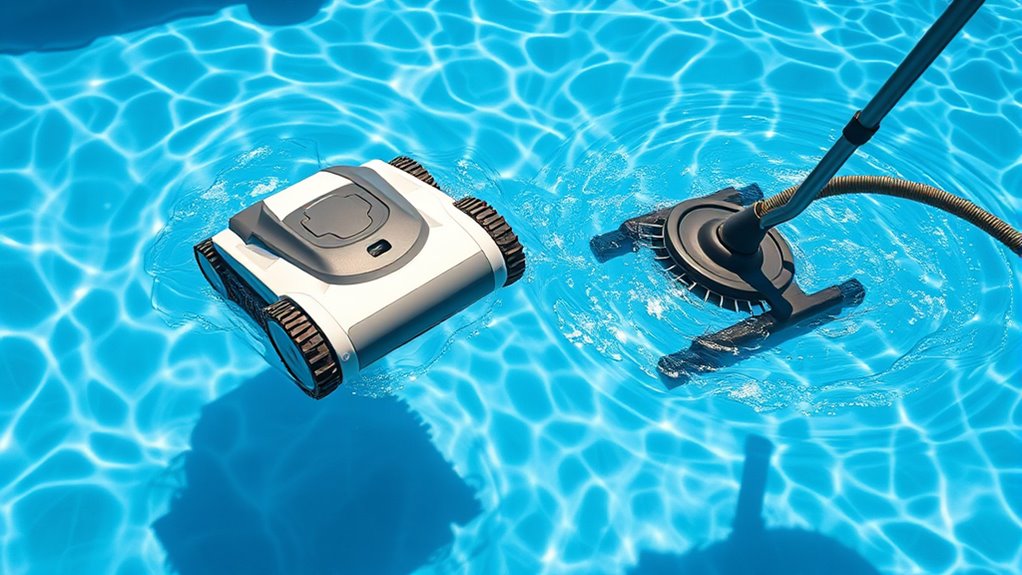
Robotic pool cleaners often outperform pressure models in cleaning performance because they are designed to navigate complex pool surfaces and reach difficult spots automatically. They effectively scrub and vacuum debris, ensuring a thorough clean even in tight corners or along the waterline. Their advanced sensors and precise movement improve water circulation, helping maintain proper pool chemical balance. This results in cleaner water and less manual intervention.
Consider these points:
- They adapt to different pool shapes and surfaces for all-encompassing cleaning
- They target stubborn dirt and algae more efficiently
- Their consistent operation promotes better water circulation and chemical balance
Suitability for Different Pool Sizes and Types
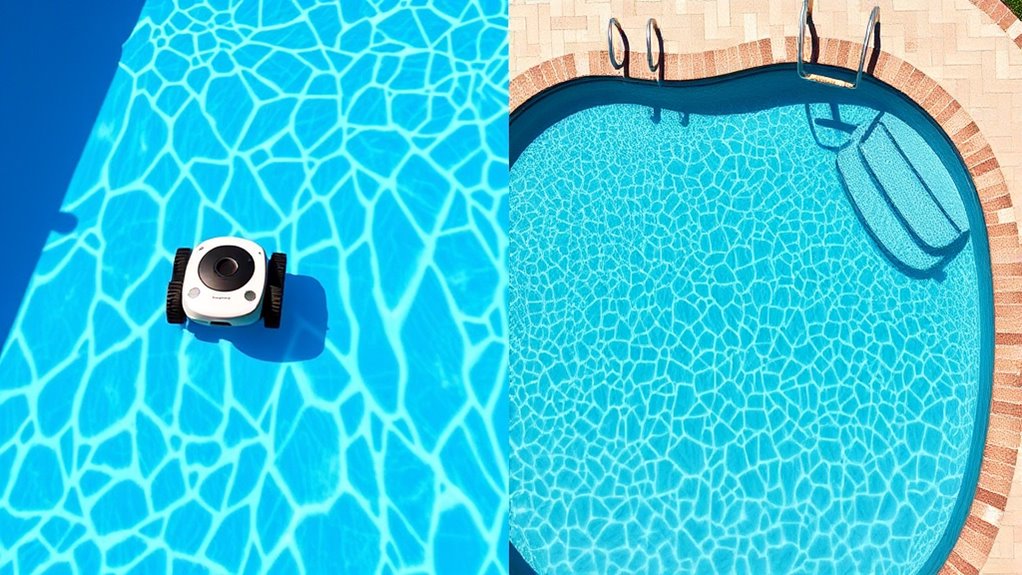
Robotic pool cleaners are highly versatile when it comes to handling different pool sizes and types, making them suitable for a wide range of setups. Whether you have a small, round spa or a large, rectangular in-ground pool, these cleaners adapt well to various pool shapes. They perform efficiently across different water temperatures, maintaining cleaning power even in colder or warmer conditions. For pools with complex shapes, robotic cleaners navigate corners and tight spaces more effectively than pressure models. Their adjustable cleaning patterns and sensors ensure thorough coverage regardless of size. Additionally, they are ideal for pools with varying water temperatures, as their technology isn’t affected by temperature fluctuations. Overall, robotic cleaners offer flexibility and reliable performance for almost any pool size or shape.
Installation and Setup Process
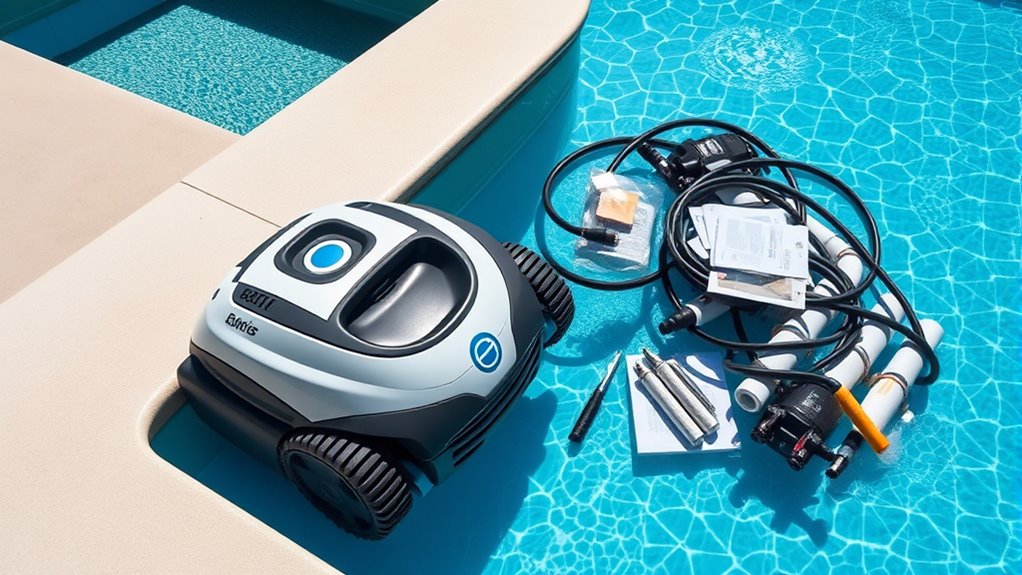
Installing a robotic pool cleaner is a straightforward process that requires minimal tools and time. You’ll find the installation complexity is low, making it easy for most users. Simply unbox the unit, connect the power supply, and place the cleaner in your pool. Most models have user-friendly setup steps designed for maximum convenience.
To help you get started smoothly, keep these tips in mind:
- Ensure the filter is properly installed before use
- Position the charging station or power source in a dry, accessible area
- Follow the manufacturer’s instructions for initial calibration or pairing
This simple setup process enhances user convenience, allowing you to enjoy a clean pool with minimal effort.
Longevity and Durability Factors

The durability of your pool cleaner largely depends on the quality of materials used and how well it’s designed to withstand regular use. High-quality materials, especially those with strong corrosion resistance, ensure your cleaner lasts longer. Look for models with sturdy plastics and rust-proof components to prevent deterioration over time. To visualize, consider these factors:
| Material Quality | Corrosion Resistance | Impact on Longevity |
|---|---|---|
| Reinforced plastics | Stainless steel parts | Resists rust, extends life |
| Sealed motor casing | UV-resistant coating | Avoids wear from sun |
| Durable brushes | Anti-corrosion coatings | Maintains performance |
Choosing a cleaner with superior material quality and corrosion resistance guarantees you’ll enjoy reliable cleaning season after season.
Frequently Asked Questions
Which Pool Cleaner Is Better for Uneven or Complex Pool Shapes?
When dealing with uneven terrain or complex geometry, you need a pool cleaner that can adapt easily. Robotic cleaners excel here because they navigate obstacles and uneven surfaces with precision, thanks to their advanced sensors and customizable programming. They can reach tricky spots and cover complex shapes thoroughly. Pressure cleaners, on the other hand, might struggle with uneven terrain, making robotic options the better choice for ensuring a clean, well-maintained pool.
Can Pressure or Robotic Cleaners Handle Algae and Tough Stains Effectively?
When it comes to algae removal and tough stain cleaning, you need a cleaner that’s powerful and thorough. Robotic pool cleaners excel at scrubbing surfaces and reaching tricky spots, making them effective for stubborn stains and algae. Pressure cleaners also work well, using strong jets to dislodge debris. Either option can handle these challenges, but robotic cleaners offer more targeted and consistent cleaning for algae and tough stains.
Are Robotic Pool Cleaners Suitable for Above-Ground Pools?
Imagine you’re cleaning your above-ground pool, and a robotic cleaner glides effortlessly across the surface. Robotic pool cleaners are generally suitable for above-ground pools, thanks to their compact size and above-ground compatibility. They work well for small to medium pools, making maintenance easier. However, for very large pools, you might need a more powerful or larger model. Overall, robotic cleaners are a convenient choice for above-ground pool maintenance.
How Do Maintenance Costs Compare Over the Lifespan of Each Cleaner Type?
When comparing maintenance costs over a pool cleaner’s lifespan, you’ll find robotic models typically have higher initial prices but lower maintenance frequency, saving you money long-term. Pressure cleaners usually cost less upfront but may require more frequent repairs, increasing costs over time. The cost comparison depends on how often you need to service each, but robotic cleaners often prove more economical due to their durability and efficiency.
Do Robotic Cleaners Require Professional Installation or Programming?
When considering robotic cleaners, you might wonder about installation requirements and programming complexity. Luckily, most robotic pool cleaners are designed for easy setup—you typically just place them in the pool and plug them in. They usually don’t need professional installation or complex programming; many come with user-friendly controls or simple preset modes. This makes robotic cleaners a convenient choice, especially if you prefer a straightforward, hassle-free cleaning solution.
Conclusion
So, whether you prefer the simple charm of pressure cleaners or the high-tech allure of robotic ones, remember that investing in the fanciest model doesn’t guarantee a spotless pool. Sometimes, the most straightforward option is just enough—until it isn’t. Ironically, the more you pay, the more you might wish for a basic cleaner that gets the job done without the fuss. After all, perfection might just be a well-placed hose.


